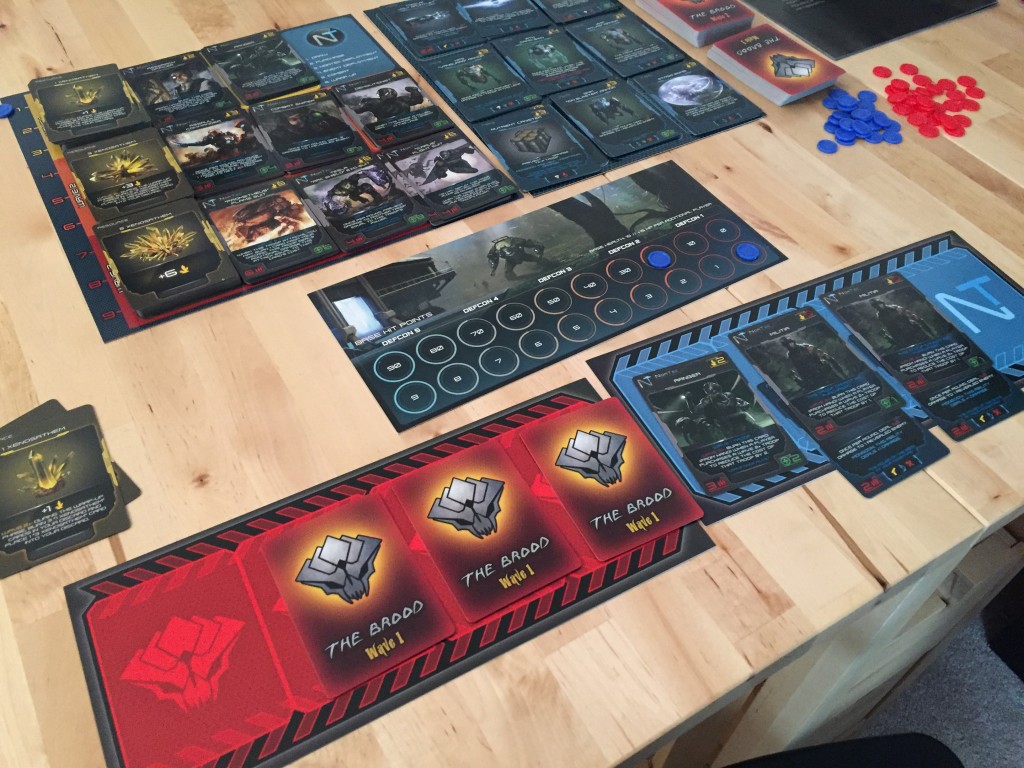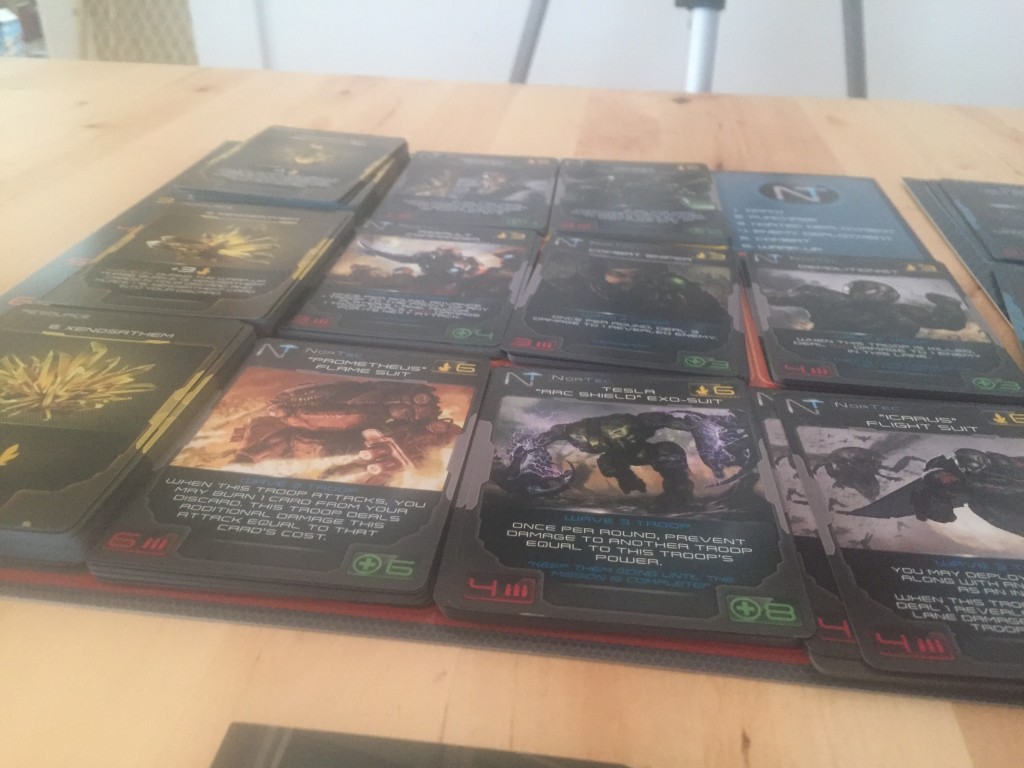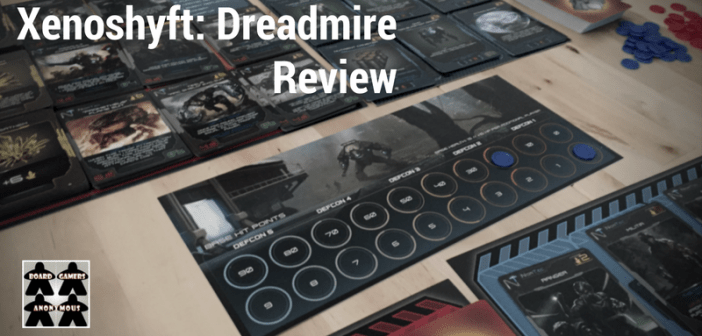Almost exactly a year ago, I cracked open a fresh new copy of Xenoshyft: Onslaught I brought home with me from Gen Con. I enjoyed it quite a bit actually, but after those initial half dozen plays before the review on Episode 87, it fell to the bottom of the rotation and didn’t get a lot of play. So I was hesitant when Xenoshyft: Dreadmire hit the table this year, at just about the same time, with just about the same mechanics.
Would I like this game any better than its predecessor? Was it still brutally (read: nigh-impossibly) hard at low player counts, and downright impossible when played solo? The answer to both of those is yes, and for both reasons I was impressed. Where a lot of games attempt to reinvent the wheel in their second iteration, Dreadmire adds just enough to be interesting without gutting what makes the original such a good game.
How Xenoshyft: Dreadmire Works
The core of the game remains intact, so if you’ve played Xenoshyft before, this is more of the same with some tweaks and small additions. If you haven’t played it before, let’s do a quick run through of how it works.
In Xenoshyft, you and up to three other players represent troops on an alien world harvesting a rare energy source, Xenosathem, that happens to be like sweet, sweet candy for a whole range of nightmare fuel creatures. Think Space Hulk but as a cooperative deckbuilder. Each player is given two lanes – one for their characters and one for the enemies that they will be facing.

Your starting deck consists of six 1-Xenosathem cards and four Militia cards. You will also get a Division card that provides some special bonuses and makes your deck and powers slightly more unique. After these are dealt out, the item array if populated from an item tracker deck. The retail edition of Dreadmire comes with 20 different item options so you’ll use just short of half of those. Each of these items have certain symbols on them as well, some of which will correspond to your Division power or discount.
The game takes place over 3 Waves, each with 3 rounds, so there are 9 total rounds. During each round, players will take turns recruiting new troops (paying with Xenosathem) and buying new items. They then deploy their troops and items to ANY lane on the table. So theirs or another players. This is super important, because you can give your troops or items that benefit another player to someone who can best use them and vice versa. Once you do that, though, those cards become theirs, so don’t thin your deck too much by helping others.

This matters because once you’ve planned your troop lane, the wave deploys. Depending on the round number and the difficulty level 3-4 enemies will appear in your lane face down. You must then face them one at a time. Each enemy has not only attack and health you must beat, but a Reveal effect that might mess with your plans (reversing order, dealing extra damage, bringing units back from the dead).
Throw in a boss monster in every wave and the game gets pretty darn difficult by the third wave.
Differences from Onslaught to Dreadmire
For those who know the Xenoshyft system and are more interested in what Cool Mini or Not changed between editions, let’s dig into the differences. They aren’t huge, but they do add some interesting elements to the game:
- More Cards! – Because Dreadmire can be combined with Onslaught, it instantly opens up options significantly, allowing you to choose which troops are available to buy, buoying the item pool and diversifying enemies. Always a good thing. This is standalone, though, so you can play without Onslaught if you do not yet have it.
- Weather – During each round, you will pull a weather card, which will list 1-3 different weather conditions – including Monsoon, Night, or Fog. Enemy cards, Division abilities, and some items will reference these conditions for either worse challenges to face or stronger abilities on your end. It throws wrenches (but also sometimes life preservers) to the team.
- Adjusted Difficulty Curve – As I mentioned before, Xenoshyft Onslaught was hard, almost too hard, especially with less than four players. The new game re-tools how enemies are deployed and therefore makes the difficulty curve a bit easier and allows you to build up to a stronger force before the end of the game. It feels like more of a progression now than a straight up beat down.
What We Like About Xenoshyft: Dreadmire
This was an easy one. I liked Onslaught but stopped playing because I never actually beat it. After nearly 10 plays, I didn’t beat it once, not even coming close. The only time we got remotely close into the final wave’s last round was with a full four at the table. It was hard to convince those four to return.

So despite how fun it was, the game didn’t make it back out, but Dreadmire’s revamped difficulty, refined language in the cards and rules, and new weather mechanic makes it work a bit better. More than anything, though, it gives more options for using the cool Xenoshyft stuff I already have.
I still love the way you can work with your fellow players to purchase items and troops as a team but then deploy them to individual stations which are then manned by those players. It creates a team atmosphere without a single decision maker overtaking the table. Everyone gets to play their lane and the damage you take affects everyone. You’ll never see all the cards either, especially with expansions, and the replayability factor here is very high.

If you’re a fan of classic sci-fi, space marines, or just plain hard-as-nails co-ops, Xenoshyft remains a top pick of the genre.
Issues with Xenoshyft: Dreadmire
One of my biggest complaints about the original game has been addressed, but the difficulty is still a pretty rough ride here, with the potential ramping up significantly in some games. The weather can even it out, or it can hammer you with bad effect after bad effect.
Another issue that hasn’t been resolved since the first game is the component quality. The mats are thin and quick to chip, the cards are all dark bordered and quickly look worn – practically requiring sleeves – and the tokens, while plastic, are small and forgettable. When you open the box and see only a big pile of 400 cards and not much else, it’s a bit disappointing, and the insert is not designed to hold cards well, so expansions will probably need to be bagged for storage.
The Bottom Line
All this aside, the game looks great on the table and has a strong thematic element that pulls everyone into the experience from the start. While a common sci-fi theme, it still doesn’t show up in board games as often as you might expect, and it really creates something unique and fun in the deck builder genre – especially as a co-op.
I still very much like Xenoshyft, and with Dreadmire, feel I might be enticed to continue playing and eventually defeat it. Combined with all the expansions on the way and the original base game and there’s a lot here to build on. It will be interesting to see how CMoN continues to grow this brand.
Disclosure: The publisher provided a copy of this game for review.


